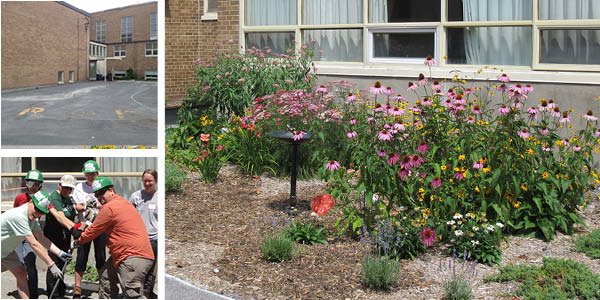Photo: a 2014 depaving project by Ecology Ottawa at Kitchissippi United Church turned a paved courtyard into a thriving pollinator garden
Depave Paradise is an exciting project in which volunteers tear up areas of unused pavement by hand and replace them with green space. Since we last wrote about Depave Paradise in 2017, there have been 14 new projects – we are now up to 34 depaved sites in 18 cities across Canada.
Watch a short video to learn more.
Thanks to support from the Ontario Trillium Foundation, Green Communities Canada members and partners in Ontario will be depaving and planting 33 more sites over the next two years (36 total from 2018-2020). There are plans for depaving projects in Kingston, Peterborough, Hamilton, Aurora, Mississauga, Thunder Bay and Ottawa, among other Ontario cities. Do you know of a group that would like to begin depaving? Get in touch and see what we have to offer!
Explore our new story maps (part of our new, redesigned website) to learn about projects that have been completed so far.
The concept of Depave Paradise is simple: we empower citizens to transform ugly areas of pavement into beautiful green spaces, using their own power. The depaving and planting events are fun community activities that bring together volunteers to accomplish a challenge. They also attract media attention, and provide a platform to discuss the problems with over-paving and stormwater runoff to a wide audience. Once the depaving and plantings are over, the result is a long term positive impact on the community, and on local waterbodies.
Our projects are generally small – in order to be appropriate for hand depaving, most sites are no more than a couple hundred meters squared. But the impacts add up. In Hamilton, Ontario, Green Venture has been hosting Depave Paradise events since 2012. They have now depaved at eight different sites within the city, including six schools, in some cases creating the only green space on school properties.
In total, our 34 Depave Paradise projects keep nearly 6000 cubic meters of stormwater out of waterbodies annually. They’re also inspiring people to take on their own depaving projects at home. Depaving of driveways has been a topic of interest in several communities – getting rid of them altogether, or replacing them with permeable alternatives.
In the eyes of a depaver, unused pavement is no longer a permanent eyesore, but an opportunity for beautification. Over time, we hope to see communities adopting broader strategies for reducing impervious surface and managing rain where it falls with green infrastructure. In the meantime, we keep chipping away at the asphalt – every bit makes a difference!

